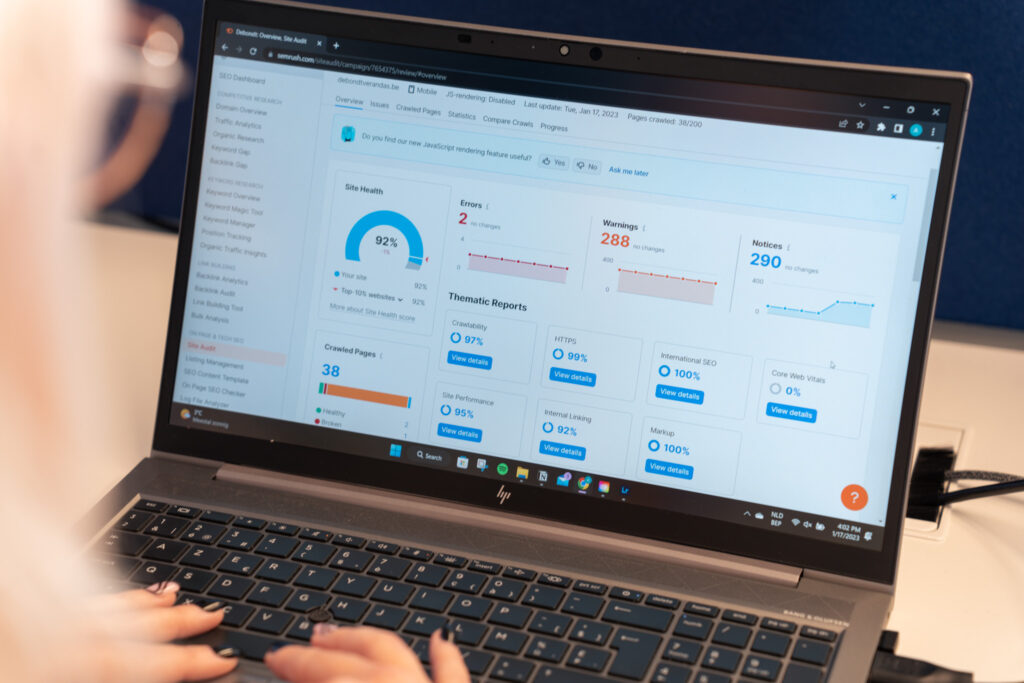A crucial aspect of digital marketing is reaching more potential customers by increasing your visibility in search engine results. That’s what you do with SEO. SEO is the process of improving the visibility and ranking of a website or webpage in organic search results. Starting with SEO can be overwhelming, but with proper guidance, it is easy to understand and implement. In this blog, we will discuss how to get started with SEO, as well as some basics such as loading speed, keyword research, on-page optimisation, link building, etc.
SEO is the abbreviation for Search Engine Optimisation It is the improvement of a website with the aim of obtaining a higher position in the organic search results of search engines. The higher you rank in the search engines, the more likely users are to visit your website. Of course, SEO is not to be confused with SEA. SEA stands for Search Engine Advertising and are paid ads that appear among search results. So with SEA, you are going to pay to rank first in Google. With SEO, it happens organically and you are not going to pay. Find out more about SEO and SEA in our blog ‘SEO & SEA: the roadmap to more website visitors‘.
By starting with SEO and optimising your website, you can rank higher in the organic search results in the search engines. For businesses, being easily found online is a must. This can be done by having a higher position in Google. The best position as a business is on the first page in the search results. But how do you actually get there? When making your website SEO proof, there are a number of factors to consider.

These factors are the three pillars of SEO. These are the 3 types of SEO you can optimise on your website.
A user should be able to have a nice experience on a website. As a result, Google is going to recommend websites based on speed, security and usability. This is the first pillar, namely technical SEO.
To analyse the technical SEO of your website, you can only ask yourself questions:
The loading speed of your website plays a factor in visitors’ user experience. You can test these with tools such as Pagespeed Insights or lighthouse. But what causes a slow website? Photos, videos and animations give you an attractive website, but these slow down tremendously. Make sure you have only the necessary animations on your website. Can it be done without? Even better! In addition, it is important to have only the necessary CSS and Javascript on your website. So delete the unnecessary files such as fonts and plugins you don’t use.
Search engines consider it very important to send people to a secure website. To distinguish between a secure and non-secure website, SSL certificates are used. An SSL certificate is a file that provides enhanced data security between your website’s server and a browser (such as Google Chrome or Safari). By default, a website has ‘http’ in front of the URL. For a website with an SSL certificate, this is ‘https’. You can request such a certificate very easily through your website’s hosting party and they will install it on your website.
To ensure a user-friendly website, it must be crawled and indexed. Website crawling is the process by which Google browses and reads your website page by page to find out what your website is about. Indexing a website is the step after crawling. This is where Google is going to determine whether your content is good enough to be found. This is called indexing because the Google database is called the index. So this is where it is important that your website is crawled and your content included in Google’s index, with the right keywords/keyword phrases. This way, you can be found in search results. In addition, there should also be no dead links on your website, i.e. 404 pages. These are pages that no longer exist and are not redirected to the correct page. You therefore want to display this as little as possible so as not to interrupt the website visitor’s search process.
The URL of a page is also a usability factor. It should be easy to read. The URL consists of the domain name and the slug. The slug is the part after /. Usually, the title of the page becomes the slug but make sure it is easy to read and contains the page’s keyword. The URL is maximum 65 characters, but is best kept as short as possible.
The second pillar is content SEO. This is where the content of the text, images and videos on your website comes into play. Before you start SEO, it is useful to think about some questions such as:
A first step is to conduct keyword research. A keyword is a term entered into a search engine such as Google to perform a particular search. The results you get there are the search results. In a keyword research, you will find out what terms people use when they search for your products and/or services. Here you will then choose from the relevant keywords you want to be found on. You can get these keywords from tools like Semrush or Google Search Console (which are free!). When determining your keywords, it is useful to take into account keyword difficulty, i.e. how difficult it is to rank for that keyword. The higher the percentage, the more difficult. This therefore means that there is a lot of competition on that keyword. After keyword research, it is important to check whether your website provides enough content for the keywords and also that each keyword has its own landing page.
Every page on your website should contain a meta title and description. This is the title and description of the page that is visible in a search engine’s search results. These are also known as the SEO snippets. They should describe what the page is about. A meta title is 60 characters and contains the description of the page, brand name, keyword the page is based on and the USP. The meta description is 120 characters and contains the description of the page, the keyword and a call-to-action. Both then also contain the keyword the corresponding page is about. This is a must implement on your website, otherwise the search engine itself is going to create a meta title and description that is not attractive to potential website visitors.
The images that appear on your website must contain a number of things to make them easy to read. First, images must contain an alt tag. This is a title attached to the image and also contains the keyword of the corresponding page. The image should also contain a proper name. This is because search engines read what is in the image, and by giving a correct name and alt tag, search engines can display the correct search results. In addition, images should also be the right size and format. The image size is best as low as possible. Try to stay lower than 300 kB. Your images are also best in webp format. This is an alternative to JPG and PNG, but is smaller and has the same quality. So these are great to use on your website.
The content on the page itself is also a very important factor for the search engines. After all, it should be well and legibly written. There should also be enough content on the page. The minimum length of content on your website is 600 words and a blog 1000 words. This content can be used to determine whether it is relevant to the visitor or not. Here, it is also imperative that the right keyword is implemented on the page and also in the right quantity. This is the keyword density. When using the keyword too much, you are doing keyword stuffing and this comes across as spam. The keyword must also be used in the headings on the page viz. H1, H2, H3, etc. Also, each page on your website should contain its own content and no duplicate content should be present.
Besides technical and content SEO, there is a third pillar, authority. Your website should be relevant and qualitative for potential website visitors. This is determined by link building. Link building is the creation of links internally and externally. Internal link building is pointing to pages within your own website. External link building is referring another external website to your website. External links are especially important for search engines and contribute the most to your website’s authority. For a search engine, you will be considered an expert on a particular subject which will make your website much easier to find. Of course, you have to be careful that they are not toxic and spam links because then your authority will fall back. You can check this in a tool like Semrush. So can you create internal or external links on your website? Then be sure to do so! And increase your authority in the search engines.
So SEO is a long-term process of optimising your website to create more visibility in the search engines. Is your website not SEO proof yet? Then definitely get started with this 101. Need even more SEO training? You certainly can! Then be sure to check out our SEO basic training or our SEO advanced training for more information.

Co-Founder & CCO | Lead On Performance Marketing
Digital Marketing Consultant building a bridge between digital & data
That way, you’ll always stay on top of the latest digital trends and developments, and then be able to use them yourself!
Oudenaardsesteenweg 256 box 5
9420 Erpe-Mere
Monday - Friday.
8 AM - 6 PM
Copyright 2024 Lead On – BTW BE 0771.335.288 – Privacy – Terms and conditions